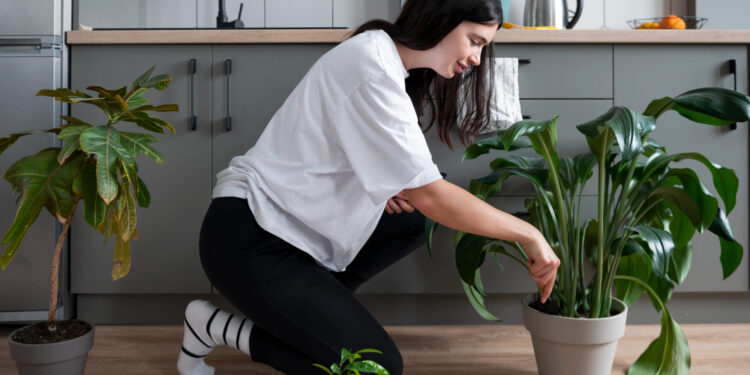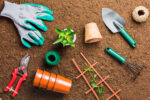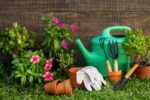How to Grow Plants at Home: Beginners Guide

Are you looking to add some greenery and life to your home by growing plants? Maybe you want to grow vegetables or herbs for cooking or just enjoy the beauty of flowers and foliage. Whatever your reason, gardening at home is a fulfilling and rewarding experience. Growing plants at home can seem like a daunting task, especially for beginners. But with a little bit of knowledge and some simple tips, anyone can successfully grow plants at home.
In this beginner’s guide, we will walk you through the basics of how to grow plants at home. Also, we will provide some helpful tips and tricks to ensure your plants thrive.
Choosing the Right Plants
The first step in growing plants at home is choosing which plants to grow. This decision should be based on your personal preferences, available space, and the amount of care and attention you are able to provide. It’s essential to choose plants that are suitable for your specific environment.
When selecting plants, consider factors such as sunlight, temperature, and humidity. For example, choose drought-resistant plants if you live in a hot and dry climate. If you have limited space, consider growing vertical gardens or compact varieties of plants.
Read More: How to Troubleshoot Common Issues in Herb Cultivation
Understanding Plant Needs
Once you have chosen the right plants for your home, it’s important to understand their basic needs. All living organisms require certain things to thrive, and plants are no exception. The three main elements that plants need to grow are water, sunlight, and nutrients.
Water is essential for plants as it helps transport nutrients throughout the plant and keep its cells turgid. Ensure you water your plants regularly but not too much, as overwatering can be harmful. Just remember, that different plants need different amounts of water.
Sunlight is another crucial factor for plant growth. Most plants require at least 6 hours of sunlight per day, but some may need more or less depending on their species. If you don’t have access to natural light, consider investing in grow lights for your indoor garden.
Lastly, plants need nutrients to grow and thrive. You can provide them with nutrients by using fertilizers or compost. Make sure to choose the right type of fertilizer for your plants and follow the instructions carefully.
Preparing the Soil
Healthy soil is crucial for growing healthy plants. Before you plant, make sure to clear your soil of any weeds or debris. You can also mix in some compost or organic matter to improve the soil’s fertility and structure.
Different plants have different soil requirements, so it’s essential to research the specific needs of your chosen plants. Some may require well-draining soil, while others do well in moist soil. Testing your soil can also help determine its pH level and nutrient content.
Planting Your Garden
Now that you have chosen your plants, understood their needs, and prepared the soil, it’s time to start planting! Make sure to follow the instructions provided by the plant’s packaging for proper spacing and depth.
Giving your plants enough room to grow is essential, as overcrowding can lead to competition for resources and stunted growth. You can also consider companion planting, which involves growing different plants together to benefit each other.
Providing Care and Maintenance
Growing plants at home requires regular care and maintenance. This means you’ll need to water, fertilize, prune, and keep an eye on pests. Make sure to check on your plants regularly and address any issues that may arise.
Watering should be done consistently, but the frequency may vary depending on the plant’s needs and environmental factors. Fertilizing can be done every 2-4 weeks, following the instructions provided by the fertilizer. Pruning helps promote healthy growth and removes dead or damaged parts of the plant.
Pest control is an important aspect of plant care, as pests can damage or even kill your plants. Be on the lookout for signs of pests and take appropriate action to prevent infestations.
You can use natural methods or commercial products to control them. I recommend researching organic and eco-friendly options to minimize the use of harmful chemicals.
May Need: Why Incorporating Mushrooms in Diet is Beneficial
Harvesting Your Plants
If you are growing edible plants such as vegetables or herbs, you can look forward to harvesting and enjoying the fruits of your labor. Make sure to harvest at the right time when the plants are at their peak ripeness. This way, you’ll get the best flavor and all the nutritional benefits.
For flowers, regular deadheading (removing spent blooms) can help promote continuous blooming and keep your plants looking healthy and vibrant. You can also experiment with drying or pressing flowers to preserve them.
Helpful Tips for Growing Plants at Home
- Start small and choose easy-to-grow plants if you are a beginner.
- Don’t hesitate to reach out for help or advice from seasoned gardeners!
- Keep track of your plants’ growth by taking photos or keeping a journal.
- Use organic and eco-friendly products to maintain a healthy environment for your plants.
- Think about using raised beds or containers for easier upkeep and improved drainage.
- Change up your crops each season to keep the soil healthy and prevent nutrient depletion.
Conclusion
Growing plants at home is a beautiful hobby that adds beauty and life to your living space and provides many benefits. With proper planning, preparation, and care, you can successfully grow a variety of plants at home. Remember to enjoy the process and not be discouraged by failures; they are all part of the learning experience.
Frequently Asked Questions
How often should I water my plants?
The frequency of watering depends on the plant species and the surrounding environmental conditions. A helpful guideline is to water your plants when the top inch of soil feels dry. Just be careful not to overwater, since that can cause root rot!
Which soil type is optimal for indoor plants?
Most indoor plants thrive in a well-draining potting mix. Look for a mix that retains moisture while allowing excess water to drain, helping to prevent root rot.
How can I determine if my plant receives sufficient sunlight?
Leggy growth and pale leaves are signs of insufficient sunlight. If you notice these symptoms, try moving the plant to a brighter location or consider using grow lights.
What common indoor plant pests, and how can I deal with them?
Common pests include aphids, spider mites, and mealybugs. You can manage these pests by using insecticidal soap and neem oil or by washing the plant with a solution of water and mild dish soap.
When should I repot my plants?
Repot when you notice roots growing out of the drainage holes or if the growth has slowed down significantly. Generally, repotting every 1-2 years is sufficient for most houseplants.
Can I use tap water for my plants?
Tap water is generally fine for most plants, but some may be sensitive to chlorine or fluoride. Let the water sit for 24 hours to allow these chemicals to evaporate, or use filtered water for sensitive plants.
Read More Blog Posts:
Interesting History of Mushrooms and Their Growth Process
7 Things to Consider Before Trying Psychedelics






